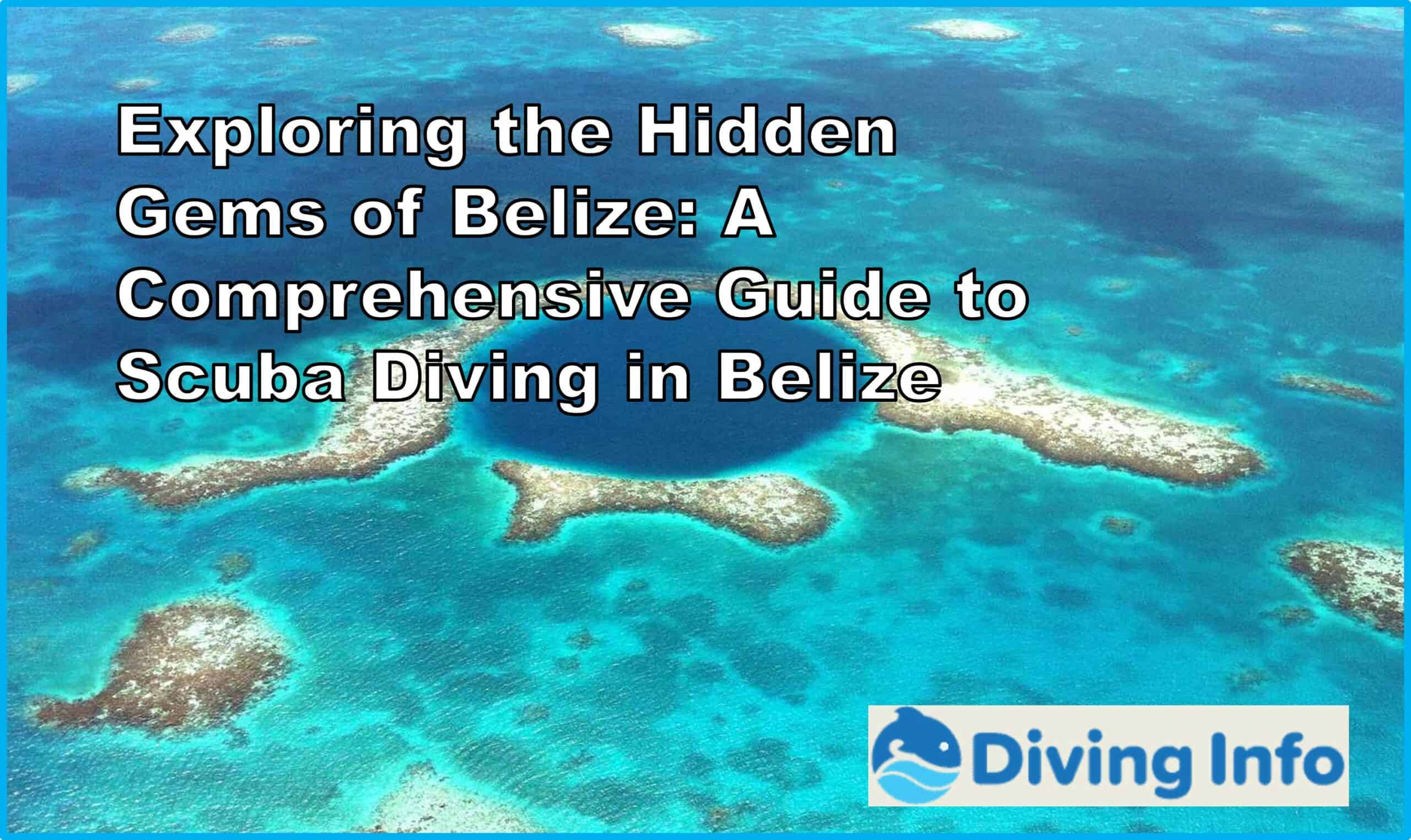*This post may contain affiliate links. As an Amazon Associate we earn from qualifying purchases.
Scuba diving in Belize is an adventure that will stay with you forever. As a diver, you will encounter a wide variety of marine life and stunning coral formations. Belize’s crystal-clear waters are home to over 500 species of fish and 100 types of coral, making it a top scuba diving destination.
Belize’s Barrier Reef is the second largest in the world, after Australia’s Great Barrier Reef. The reef stretches for over 190 miles from Mexico down to Honduras.
Many consider it to be the best scuba diving destination in the Caribbean. The warm waters of the Caribbean Sea are perfect for scuba diving year-round, with water temperatures ranging from 78-84°F (25-29°C).
You may be interested in my other articles about Dive Gladden Spit or Philippines Liveaboard.
Scuba Diving in Belize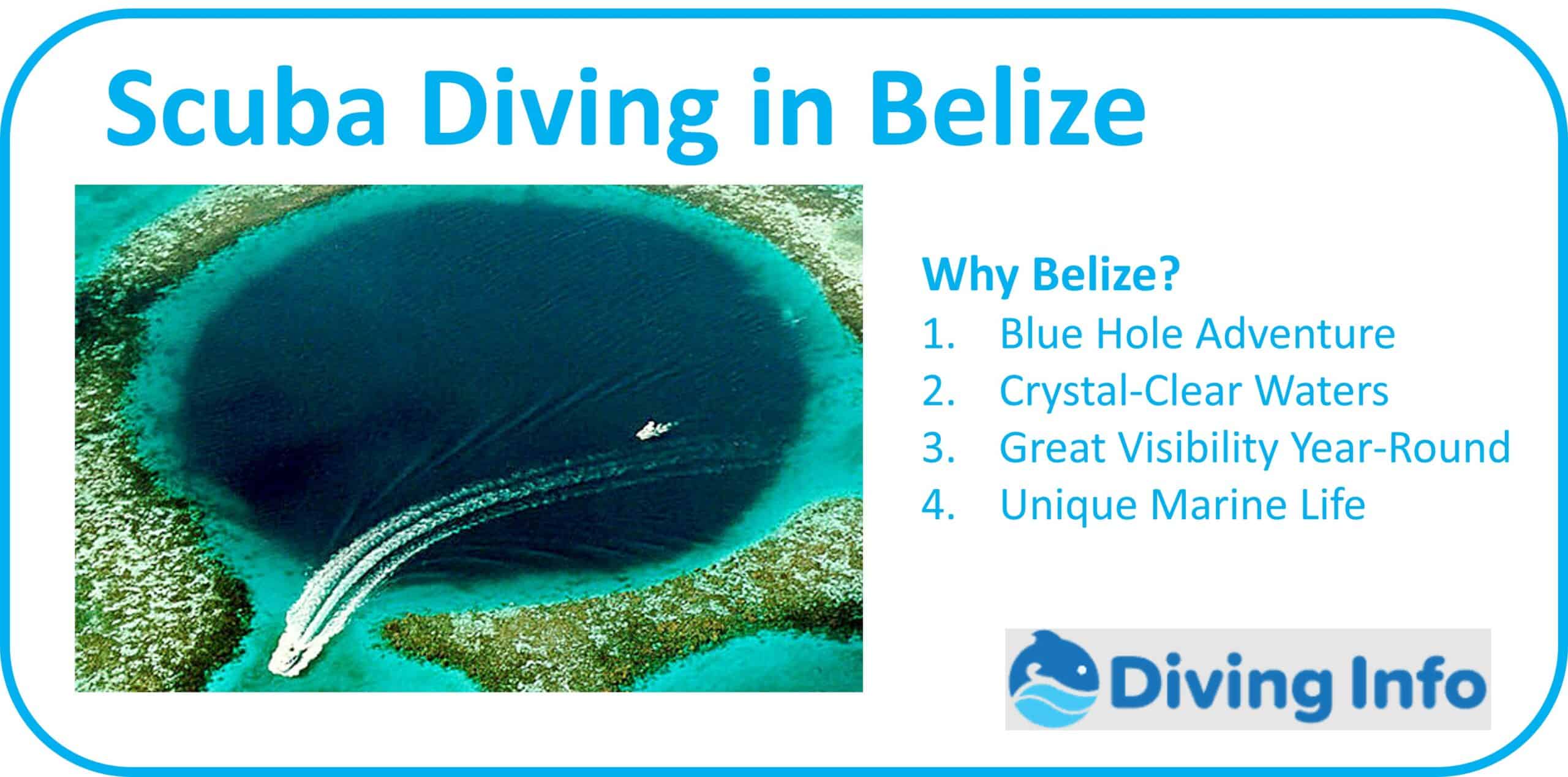
Belize has many different types of dive sites that cater to all levels of experience. From novice divers to experts, there is something for everyone in Belize.
You can choose from shallow coral gardens or deeper walls and drop-offs that offer breathtaking views and encounters with larger pelagic species like sharks. One unique aspect of scuba diving in Belize is its famous Blue Hole – a giant submarine sinkhole off the coast of Belize that was made famous by Jacques Cousteau in the early 1970s.
The Blue Hole plunges more than 400 feet deep into an underwater cave system and is a popular spot for advanced divers. For those who love underwater photography, Belize offers some fantastic opportunities to capture stunning images thanks to its clear waters and diverse marine life.
Keep an eye out for colorful parrotfish, sea turtles, vibrant sponges, schools of tropical fish like angelfish and butterflyfish as well as larger species like eagle rays and nurse sharks. If you’re looking for adventure under the sea then look no further than scuba diving in Belize!
With its crystal-clear waters teeming with life including reef sharks, sea turtles and colorful schools of fish – it’s truly one of the best diving destinations in the world. From shallow coral gardens to deeper walls and drop-offs, there is something for every level of diver, making Belize a must-visit for all scuba diving enthusiasts. Try a liveaboard dive charter in Belize for an even better experience.
Intro to Belize Diving
Belize is a beautiful and unique destination for scuba diving enthusiasts. With clear, warm waters and pristine coral reefs, it’s no wonder that divers from around the world flock to this Central American country to explore its underwater treasures. Whether you’re a seasoned pro or just starting out with scuba diving in Belize, this brief guide will give you an introduction to the country’s diving scene.
Scuba diving in Belize is most famous for its impressive barrier reef system. The Belize Barrier Reef is the second-largest coral reef system in the world, after Australia’s Great Barrier Reef.
It stretches for over 190 miles (300 km) along the coast of Belize and is home to a vast array of marine life. The reef system consists of several distinct sections, each with its own unique characteristics and attractions.
One popular section of the barrier reef is Ambergris Caye. Located off the northern coast of Belize, Ambergris Caye offers some of the best diving spots in the country.
Here you’ll find colorful coral gardens teeming with fish, as well as plenty of opportunities for encounters with larger creatures such as rays and turtles. Another must-visit area for scuba diving in Belize is Turneffe Atoll.
This remote atoll sits about 20 miles (30 km) off the coast and boasts an incredible variety of dive sites. From shallow coral gardens to deep walls dropping into the abyss, Turneffe Atoll has something for divers at every level.
With so many fantastic dive sites on offer, it’s no surprise that scuba diving in Belize attracts both novice divers and experienced professionals alike. Whatever your skill level or interests may be, there are plenty of opportunities to explore this stunning underwater world.
Of course, before you can go scuba diving in Belize you need to know how to get there! Fortunately, getting to Belize is relatively easy from many parts of North America and Europe.
Most international flights land at Philip S. W. Goldson International Airport in Belize City, which is the country’s main airport. Once you’ve landed in Belize, you can either take a domestic flight or hop on a bus to your final destination.
Many of the top scuba diving spots are located on offshore islands and atolls, so you’ll likely need to take a boat or water taxi to reach them. But trust us – the journey is well worth it!
Diving the Belize Barrier Reef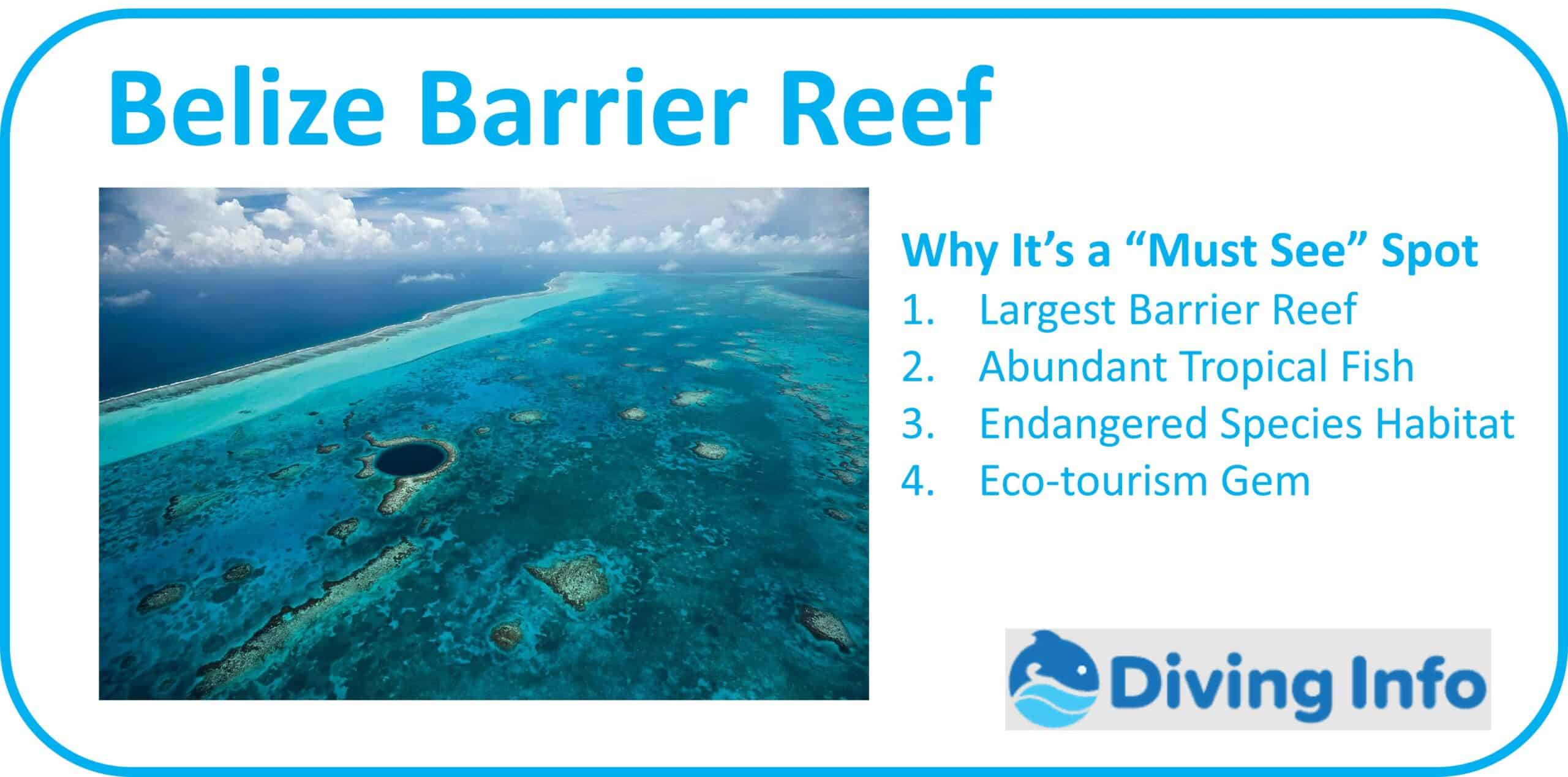
As one of the world’s most pristine reef systems, the Belize Barrier Reef offers some of the best scuba diving in Belize. The Barrier Reef is a 190-mile long section of coral reefs that spans the entire coast of Belize. It is part of the larger Mesoamerican Barrier Reef System which runs from Mexico to Honduras.
Diving at the Belize Barrier Reef is a surreal experience as it is home to over 500 species of fish and countless species of coral, sponges and other invertebrates. Divers can expect to see schools of brightly colored tropical fish, eels, rays, nurse sharks and even dolphins if they are lucky.
One popular dive site along the barrier reef is Turneffe Atoll which sits at the southern end. Turneffe Atoll has dozens of dive sites that range from shallow coral gardens to deep walls that descend hundreds of feet into darkness.
The waters around this area are perfect for drift diving as currents here can be swift. Another popular area for scuba diving in Belize along the barrier reef is Lighthouse Reef which is located at its northernmost point near Ambergris Caye.
Here divers will find some incredible blue holes and drop-offs such as The Great Blue Hole which was made famous by Jacques Cousteau in his documentary film exploring its depths. The coral formations on Lighthouse reef are also spectacular with enormous brain corals and towering sea fans that provide shelter for an array of marine life like eagle rays and turtles.
Regardless if you’re a novice or experienced diver, there are plenty of options available in this area for you to explore. In addition to Turneffe Atoll and Lighthouse Reef, there are many other amazing dive sites along the barrier reef like Half Moon Caye Wall, Glovers Atoll, South Water Caye Marine Reserve among others that offer equally stunning scuba diving experiences in Belize.
Belize Marine Life and Photography Subjects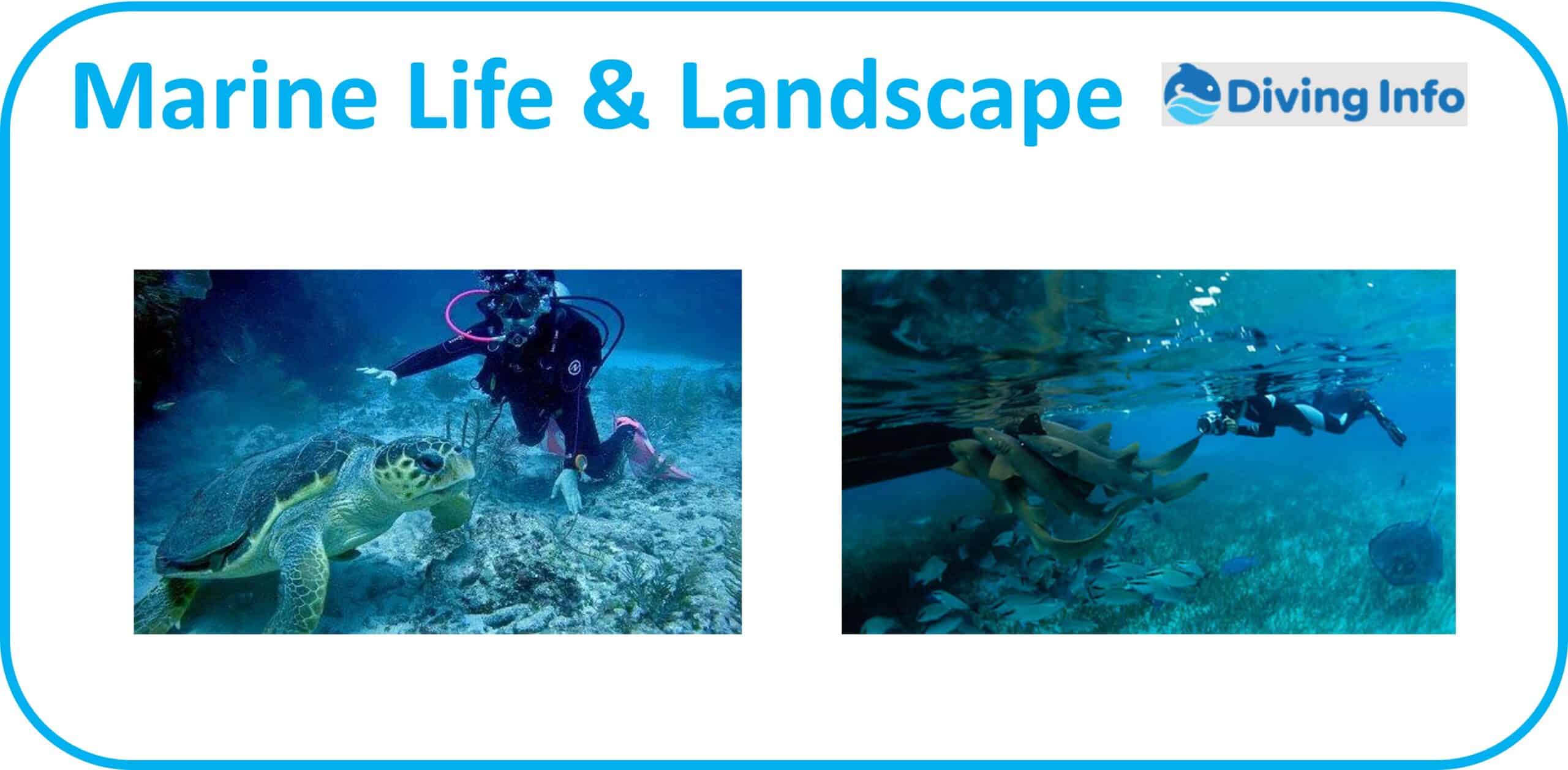
Belize’s marine life is one of the most diverse in the world, and diving in Belize offers an amazing opportunity to experience it firsthand. From colorful corals to magnificent creatures, the diversity of marine life here is truly stunning.
Divers can expect to see a wide variety of species, including parrotfish, barracudas, groupers, seahorses, nurse sharks, and eagle rays. One of the highlights of scuba diving in Belize is undoubtedly the chance to see whale sharks.
These gentle giants typically appear around Gladden Spit between March and June each year. During this time period, divers from all over the world flock to Belize for a chance to swim alongside these magnificent creatures.
Underwater photography enthusiasts will find plenty of fantastic subjects in Belize too. The clear blue waters offer perfect conditions for capturing stunning images of reef fish and other marine life.
A good underwater camera is essential if you want to capture these fleeting moments. If you’re interested in macro photography or looking for some really unique subjects to capture on camera while scuba diving in Belize, keep an eye out for seahorses and frogfish!
These elusive creatures can be difficult to spot at first but are worth searching for since they make for fascinating photography subjects. Aside from these bigger animals and photographic treasures like nudibranchs or different types of corals – don’t forget about Belize’s smaller inhabitants!
The colorful schools of tropical fish that congregate around coral heads and sea fans are also great targets if you want some beautiful shots. Overall there is never a shortage of interesting marine life waiting just beneath the surface when you go scuba diving in Belize!
Belize – Best Dive Spots
Belize is a popular destination for scuba diving, and it’s not hard to see why. With crystal-clear waters and a vibrant marine ecosystem, the country has plenty of dive sites that offer amazing experiences to divers of all levels. In this section, we’ll take a closer look at some of the best diving spots in Belize.
The Great Blue Hole is undoubtedly one of Belize’s most famous dive sites. Located off the coast of Ambergris Caye, this underwater sinkhole is over 300 meters wide and 125 meters deep.
The Blue Hole was formed during the last ice age, and its walls are covered with unique geological formations like stalactites and stalagmites. Scuba divers can explore these formations while encountering several species of sharks.
Another popular dive site in Belize that is worth checking out is Hol Chan Marine Reserve. This reserve has been protected since 1987 and has an incredibly diverse underwater ecosystem.
Divers will encounter colorful coral gardens teeming with tropical fish such as parrotfish, angelfish, and groupers. For those who are lucky enough to visit between March and June, they may be able to witness whale sharks passing through the area.
Gladden Spit is another must-visit dive site in Belize. Located off the coast of Placencia Peninsula in southern Belize, Gladden Spit offers an unforgettable experience for divers during full moon periods between March and June.
During these months, whale sharks congregate at Gladden Spit to feed on snapper spawn making it one of the few places in the world where you can swim alongside these gentle giants. South Water Caye Marine Reserve is another fantastic spot for scuba diving in Belize which boasts an impressive number of marine species including rays, octopuses, sea turtles to name just a few examples!
The reserve also features clear waters that offer visibility up to 100 feet deep making it perfect for photography enthusiasts! Shark Ray Alley is a unique dive site off the coast of Ambergris Caye known for its large population of nurse sharks and stingrays.
Divers can swim within inches of these impressive creatures, observing them in their natural habitat. This is a must-visit spot for underwater photographers looking to capture some fantastic shots.
These are just some of the best scuba diving spots in Belize, but there are plenty more to explore. No matter which dive site you choose, you’re sure to have an unforgettable experience here in this vibrant and diverse underwater world.
1. The Great Blue Hole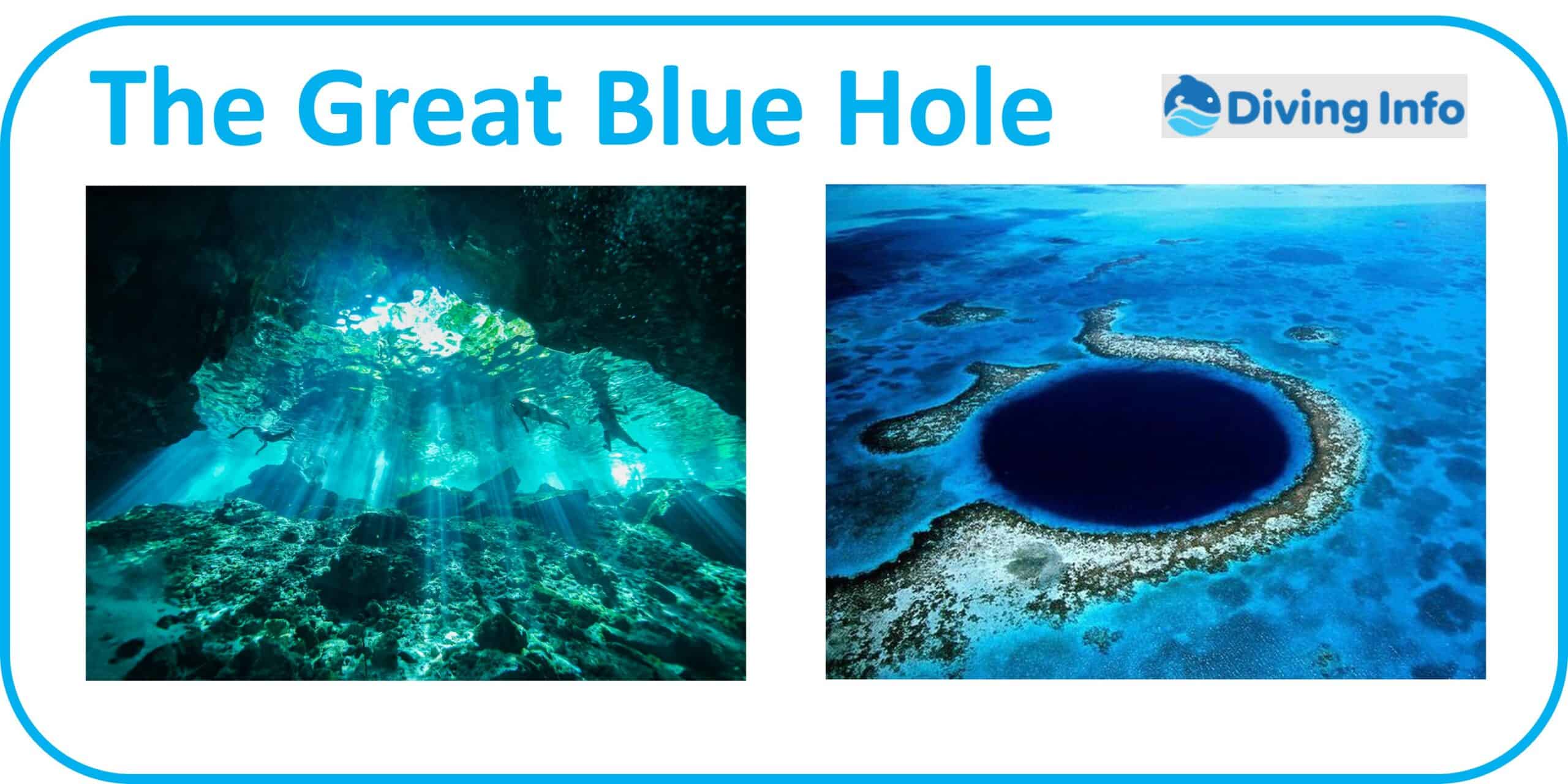
The Great Blue Hole is one of the most popular diving destinations in the world, and it’s located off the coast of Belize. The hole is a massive underwater sinkhole that was formed millions of years ago when the area was above sea level. The hole is almost perfectly round, and it’s over 300 meters wide and 125 meters deep.
It’s a must-visit spot for scuba diving in Belize. One of the reasons why The Great Blue Hole is so famous is because of its unique formations.
| Description | A massive underwater sinkhole located off the coast of Belize. |
| Unique Features | Unique formations including massive stalactites and beautiful coral formations. Also features schools of fish, and possibly sharks. |
| Best Time to Visit | Best during calm weather conditions. |
| Dive Depth | Over 300 meters wide and 125 meters deep. |
| Experience Level Required | Advanced certification due to depth. |
When you dive down to the bottom, you’ll see massive stalactites hanging from the ceiling that were formed when the area was still above sea level. You’ll also see beautiful coral formations, schools of fish, and maybe even some sharks.
Diving at The Great Blue Hole requires advanced certification due to its depth. But even if you’re not certified to go all the way down to the bottom, you can still explore around 30 meters deep and see plenty of amazing sights.
One thing to keep in mind is that visibility can sometimes be an issue due to all the sediment in the water. If you’re planning on going scuba diving in Belize at The Great Blue Hole, there are a few things you should know.
First, it’s best to go during calm weather conditions as choppy waters can make it difficult to get down into the hole safely. Second, make sure you have good buoyancy control as some areas inside are pretty tight quarters.
Overall, if you’re an experienced scuba diver looking for a unique and unforgettable experience while diving in Belize, then The Great Blue Hole should definitely be on your list. Not only will you get to witness one of nature’s greatest wonders but also enjoy an opportunity for some great photos with your underwater camera!
2. Hol Chan
Hol Chan is one of the most popular scuba diving sites in Belize, and for good reason. This marine reserve offers visitors the chance to see a diverse range of marine life, including stingrays, nurse sharks, and green sea turtles.
The name “Hol Chan” means “little channel” in Maya, referring to the narrow channel that runs through the reef. One of the unique features of scuba diving in Hol Chan is that it is divided into four zones, each with different depths and types of marine life.
| Description | A marine reserve offering a diverse range of marine life. |
| Unique Features | Divided into four zones, each with different depths and types of marine life. Known for its stingrays, nurse sharks, and green sea turtles. |
| Best Time to Visit | Anytime. |
| Dive Depth | Ranges from 8 to 30 meters (26-98 feet) depending on the area. |
| Experience Level Required | Accessible for divers of all levels. |
The first zone is the shallowest and is home to seagrass beds where you can spot southern stingrays and tarpon. Another zone is a coral garden with colorful corals, sponges, and tropical fish such as parrotfish and angelfish.
The third zone is called Shark Ray Alley, where you can observe dozens of nurse sharks and stingrays up close. These creatures are accustomed to divers’ presence here because they have been coming to this spot for years due to fisherman’s daily leftovers.
And finally, Zone 4 combines coral formations with sand channels which are perfect for observing large schools of jackfish or barracuda. One thing I love about Hol Chan is how accessible it is for divers of all levels.
The maximum depth ranges from only 8 to 30 meters (26-98 feet) depending on the area you’re exploring. So whether you’re a beginner or an experienced diver looking for a new challenge – Hol Chan has got something for everyone!
During your dive at Hol Chan be on the lookout for green sea turtles too! They’re commonly seen along with moray eels hiding between corals waiting for their next meal.
Also remember that just like any other site in Belize there are few regulations which protect all these species from overfishing or too much tourism impact. Overall, if you’re planning a scuba diving trip to Belize then Hol Chan should be on your list of must-see sites.
With its diverse marine life and accessible depths, it’s no wonder why so many divers consider it one of the best dive sites in Belize. So don’t miss out on exploring this incredible underwater world!
3. Gladden Spit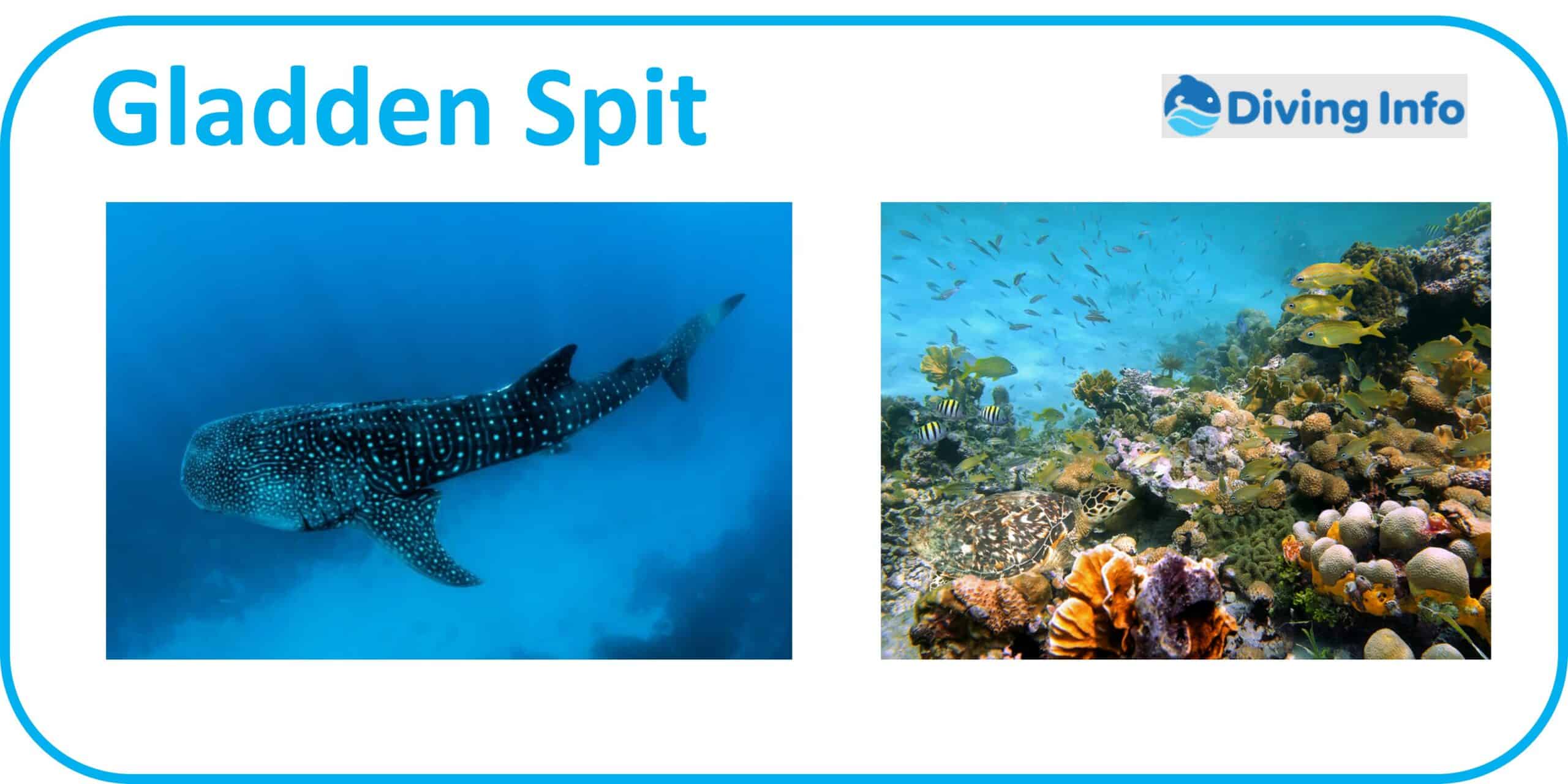
Gladden Spit is a spectacular dive site located off the coast of Placencia, Belize. It’s a must-visit for scuba diving enthusiasts who are looking for a unique diving experience.
The marine life at Gladden Spit is abundant and diverse, making it an ideal location for those interested in underwater photography. At this dive site, divers can expect to see several species of sharks, including the elusive whale shark which visits the area from March to June during the full moon.
| Description | Located off the coast of Placencia, Belize and known for its diverse marine life. |
| Unique Features | Known for its sharks, including the elusive whale shark which visits the area from March to June during the full moon. |
| Best Time to Visit | March to June during the full moon for whale sharks. |
| Dive Depth | Not specified. |
| Experience Level Required | Recommended for experienced divers due to strong currents. |
The sight of these gentle giants swimming alongside you is truly awe-inspiring and an unforgettable experience. But that’s not all; you’ll also encounter barracudas, rays, and groupers among many other species.
If you’re lucky enough to visit during the whale shark season, there’s no better place to be than Gladden Spit. These magnificent creatures are attracted to the area by snappers spawning in large numbers during this time of year.
As they come to feed on these fish eggs, divers can get up close and personal with them while they circle around them gracefully. Gladden Spit is also home to some beautiful coral formations that will take your breath away – literally!
These pristine reefs are teeming with colorful marine life such as butterflyfish and angelfish that glide effortlessly through the coral gardens. To reach Gladden Spit, you can take a boat ride from Placencia where most dive operators offer excursions to this popular site.
Dive conditions at Gladden Spit are generally good with calm waters and excellent visibility most times of the year. However, it’s recommended that only experienced divers attempt this site due to strong currents which can make diving challenging for beginners.
If you’re planning a scuba diving trip in Belize, don’t miss out on visiting Gladden Spit. This exceptional dive location offers an abundance of marine life and exciting experiences that will leave you with memories that will last a lifetime.
4. South Water Caye Marine Reserve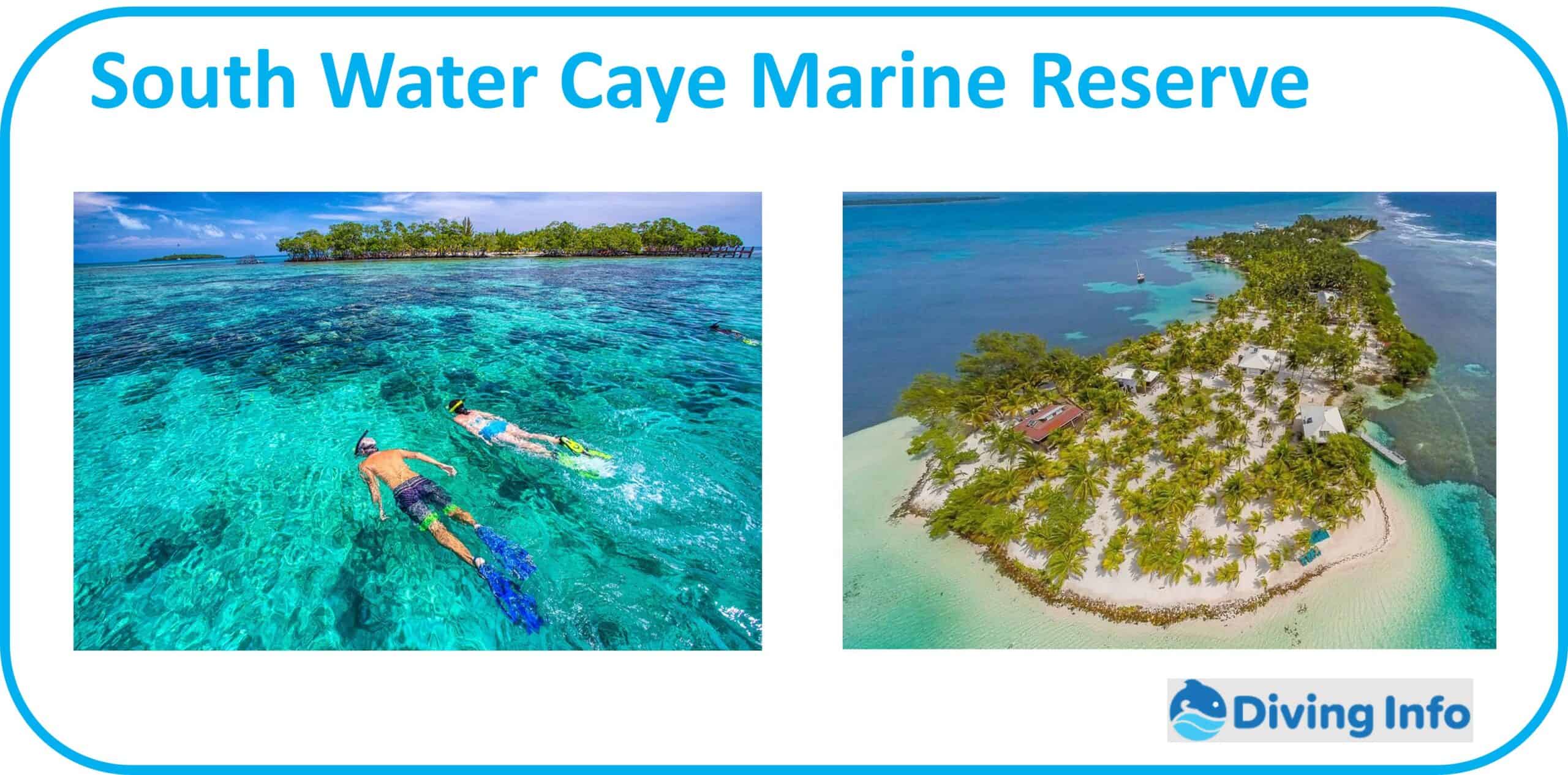
South Water Caye Marine Reserve is one of the most popular diving sites in Belize. It is located between Dangriga and Hopkins, and it covers 1175 acres of coral reefs, seagrass beds, mangroves, and tiny islands. South Water Caye itself is a small island with white sandy beaches that offers accommodations for divers.
The marine reserve was established in 1996 to protect the diverse marine life that inhabits the area. Scuba diving in South Water Caye Marine Reserve is an unforgettable experience.
| Description | Located between Dangriga and Hopkins, covers 1175 acres of coral reefs, seagrass beds, mangroves, and tiny islands. |
| Unique Features | Known for its colorful fish such as parrotfish, butterflyfish, angelfish, groupers, wrasses and snappers. |
| Best Time to Visit | Not specified. |
| Dive Depth | Not specified. |
| Experience Level Required | Not specified. |
The water visibility is usually excellent, ranging from 50 to 100 feet depending on the weather conditions. The sea bottom is mostly sandy or rocky with patches of coral formations inhabited by schools of colorful fish such as parrotfish, butterflyfish, angelfish, groupers, wrasses and snappers.
Divers can also see barracudas, jacks and occasional sharks patrolling along the reef walls or over the sand flats. The healthy coral reef formations are teeming with sponges, seafans and soft corals which provide shelters for numerous critters such as shrimps, crabs and lobsters.
One of the most exciting dive sites in South Water Caye Marine Reserve is called “Aquarium”. It is a shallow patch reef located near South Water Caye island that resembles a giant aquarium full of friendly fish!
This site offers great opportunities for underwater photographers who can capture close-up shots of damselfish guarding their eggs or blennies popping in and out of their holes. Another fantastic dive site at South Water Caye Marine Reserve is called “Triple Anchor”.
This site consists of three mooring buoys that mark different stages of a vertical wall dive. Starting at about 30 feet deep you can explore ledges full of lobsters and crabs before descending to deeper parts where you will encounter massive barrel sponges hosting cleaning shrimp stations.
Look for purple vase sponges and yellow tube sponges which are favorite subjects for macro photography. At South Water Caye Marine Reserve, there is also a unique dive site called “Tarpon Caves”.
This site is located near the northern edge of the marine reserve, and it features a series of underwater caves and tunnels that are often visited by giant tarpons. These huge silvery fish can grow up to 8 feet long and weigh over 200 pounds!
Despite their size, they are quite gentle and curious creatures that often swim alongside divers. Overall, South Water Caye Marine Reserve is a must-visit scuba diving destination in Belize for any diver who appreciates pristine coral reefs, colorful marine life, and relaxed island vibes.
5. Shark Ray Alley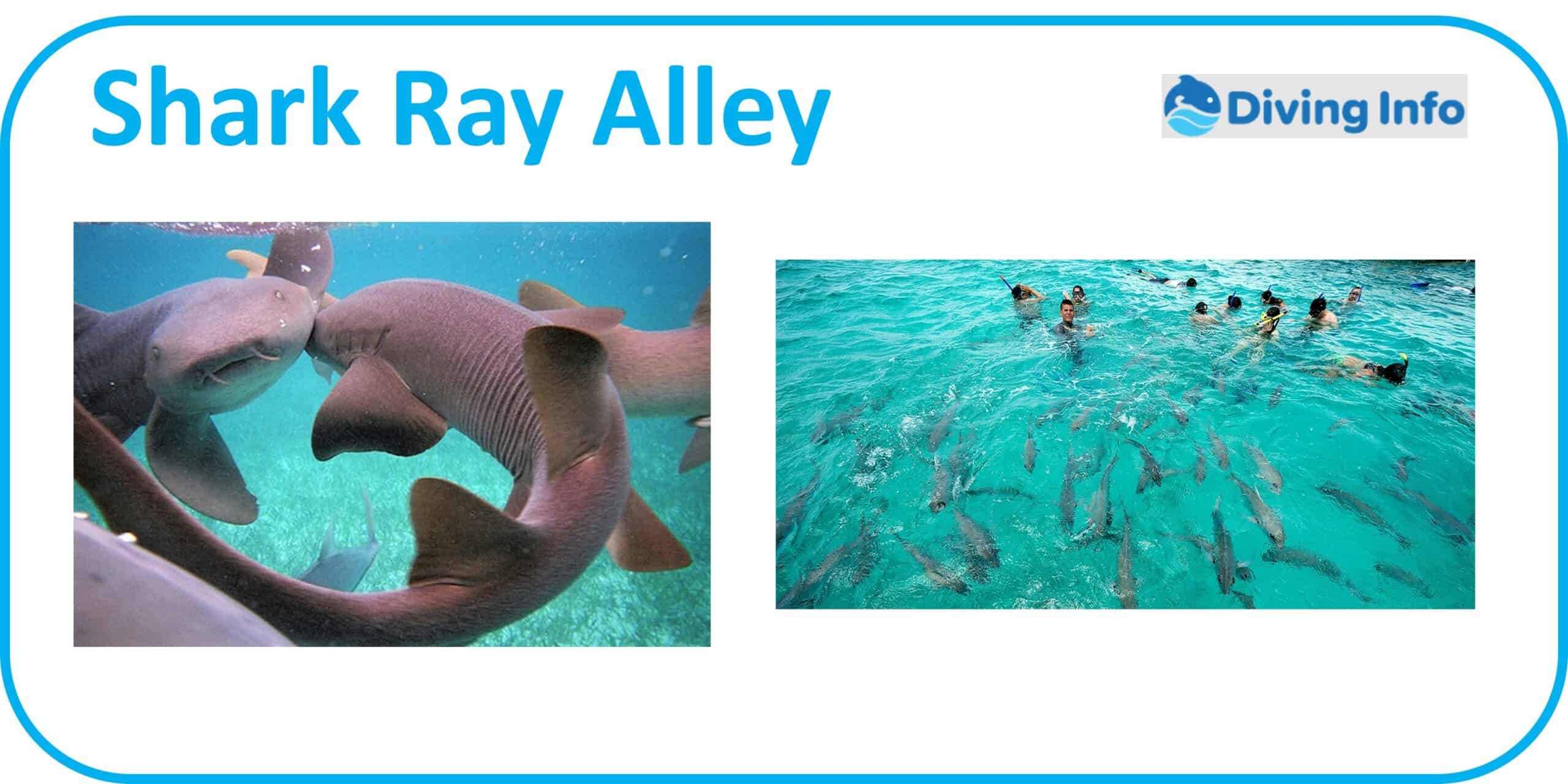
Shark Ray Alley is one of the most famous dive sites in Belize for a good reason. Located in the Hol Chan Marine Reserve on Ambergris Caye, this site is home to a large number of nurse sharks and southern stingrays. As soon as you jump into the water, you’ll be surrounded by these gentle creatures swimming all around you.
The dive site consists of a shallow sandy area where the rays and sharks gather to be fed by divers. The dive guides will scoop up pieces of fish and hold them out for the animals to come close and take it out of their hand.
| Description | Located in the Hol Chan Marine Reserve on Ambergris Caye, this site is home to a large number of nurse sharks and southern stingrays. |
| Unique Features | Known for its nurse sharks and southern stingrays. |
| Best Time to Visit | Not specified. |
| Dive Depth | Not specified but good for snorkelers due to shallow water. |
| Experience Level Required | Suitable for divers of all levels and also for snorkelers. |
It’s an incredible experience being so close to these magnificent creatures without feeling threatened or scared. If you’re lucky enough, you’ll also see some other marine life at Shark Ray Alley during your scuba diving in Belize trip.
Schools of jackfish are often seen darting around, while turtles can be found munching on seagrass at the bottom. There are also plenty of colorful reef fish hiding amongst the coral formations.
Shark Ray Alley isn’t just a great spot for diving; it’s also an excellent location for snorkelers too. Because the water is quite shallow, even non-swimmers or inexperienced snorkelers can safely enjoy this unique experience with these beautiful creatures.
Visiting Shark Ray Alley can be arranged through various dive operators or tour companies located on Ambergris Caye or Caye Caulker, two popular islands for scuba diving in Belize. They offer daily trips that usually combine several different dive sites with various levels of difficulty to cater to divers with different skill levels.
Overall, Shark Ray Alley is an unmissable stop on any scuba diving in Belize trip. Not only will you get up close with nurse sharks and southern stingrays, but you’ll also have a chance to witness some other stunning marine life species that call Belize’s waters home!
6. Esmeralda Canyons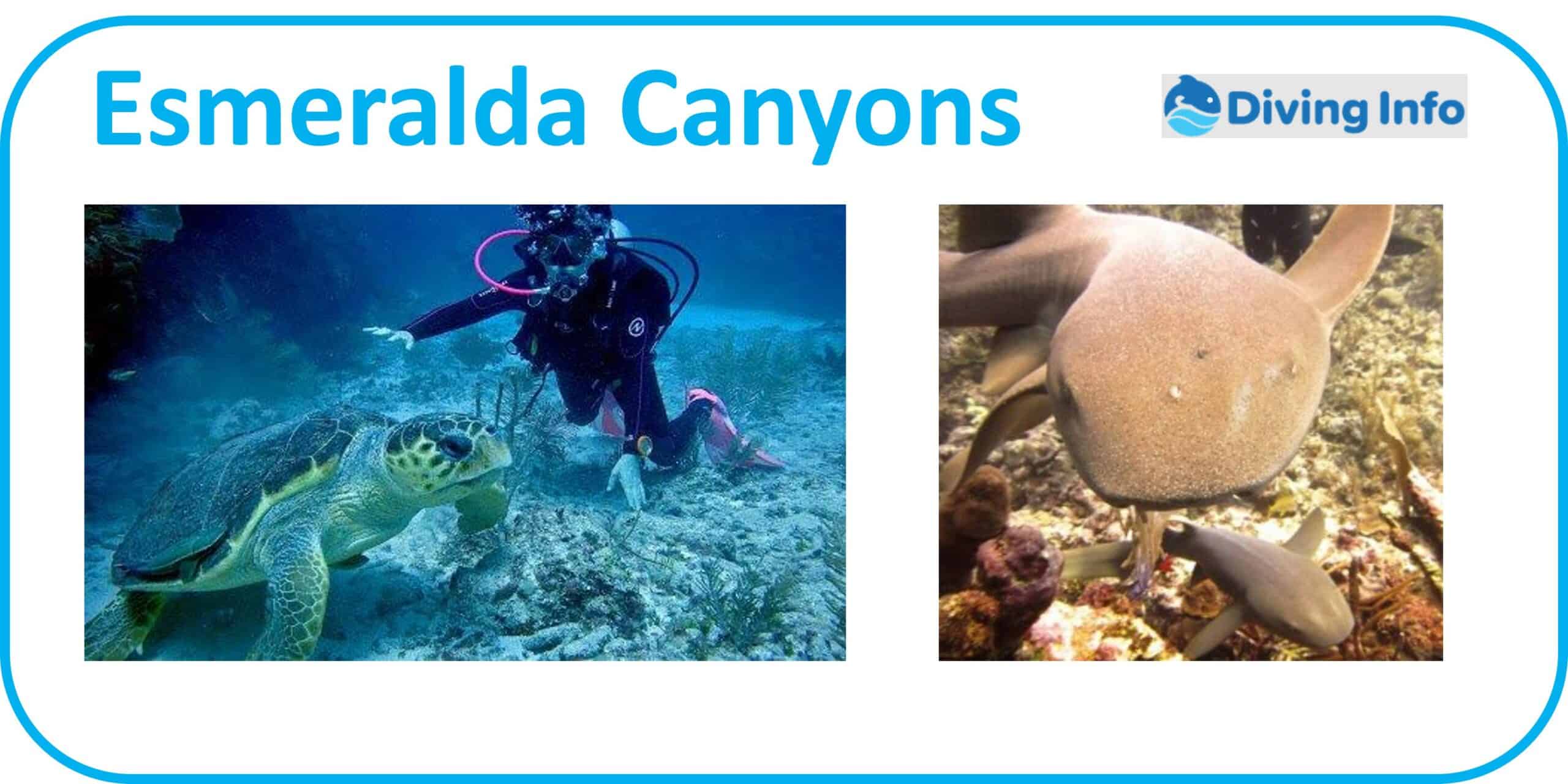
Esmeralda Canyons is one of the most beautiful diving spots in Belize. It is located just off the coast of Ambergris Caye and is part of the Barrier Reef.
The site gets its name from the stunning and intricate canyon formations found at a depth of around 70 feet. Diving in Esmerelda Canyons typically starts off with a shallow descent into a sandy area, where divers can spot various types of rays, including stingrays and eagle rays.
| Description | One of the most beautiful diving spots in Belize located just off the coast of Ambergris Caye and is part of the Barrier Reef. |
| Unique Features | The site has stunning and intricate canyon formations and chimney-like tunnels that connect different parts of the formation. |
| Best Time to Visit | During calm weather conditions when visibility is excellent. |
| Dive Depth | Around 70 feet. |
| Experience Level Required | Recommended for experienced divers due to occasional strong currents. |
As they continue to move toward the canyon walls, divers will encounter schools of colorful fish such as parrotfish, angelfish, and groupers. The narrow and winding canyons are covered in corals and sponges that provide shelter to an array of marine creatures.
Divers will be amazed by the sight of moray eels peeking out from crevices and lobsters scurrying along the walls. The canyons are also home to some larger species like nurse sharks that swim gracefully through the turquoise waters.
One unique feature of Esmerelda Canyons is its chimney-like tunnels that connect different parts of the formation. These tunnels allow divers to swim through while keeping an eye out for octopuses that often hide inside them.
The best time to dive Esmerelda Canyons is during calm weather conditions when visibility is excellent, making it easier to appreciate all its beauty. Experienced divers will enjoy exploring this site as it presents various challenges such as strong currents on occasion.
Scuba diving in Belize’s Esmerelda Canyons offers a unique opportunity for divers who want to explore one of nature’s wonders underwater. Whether you’re a seasoned diver or a newbie trying it out for the first time, this site has something for everyone!
7. Spanish Bay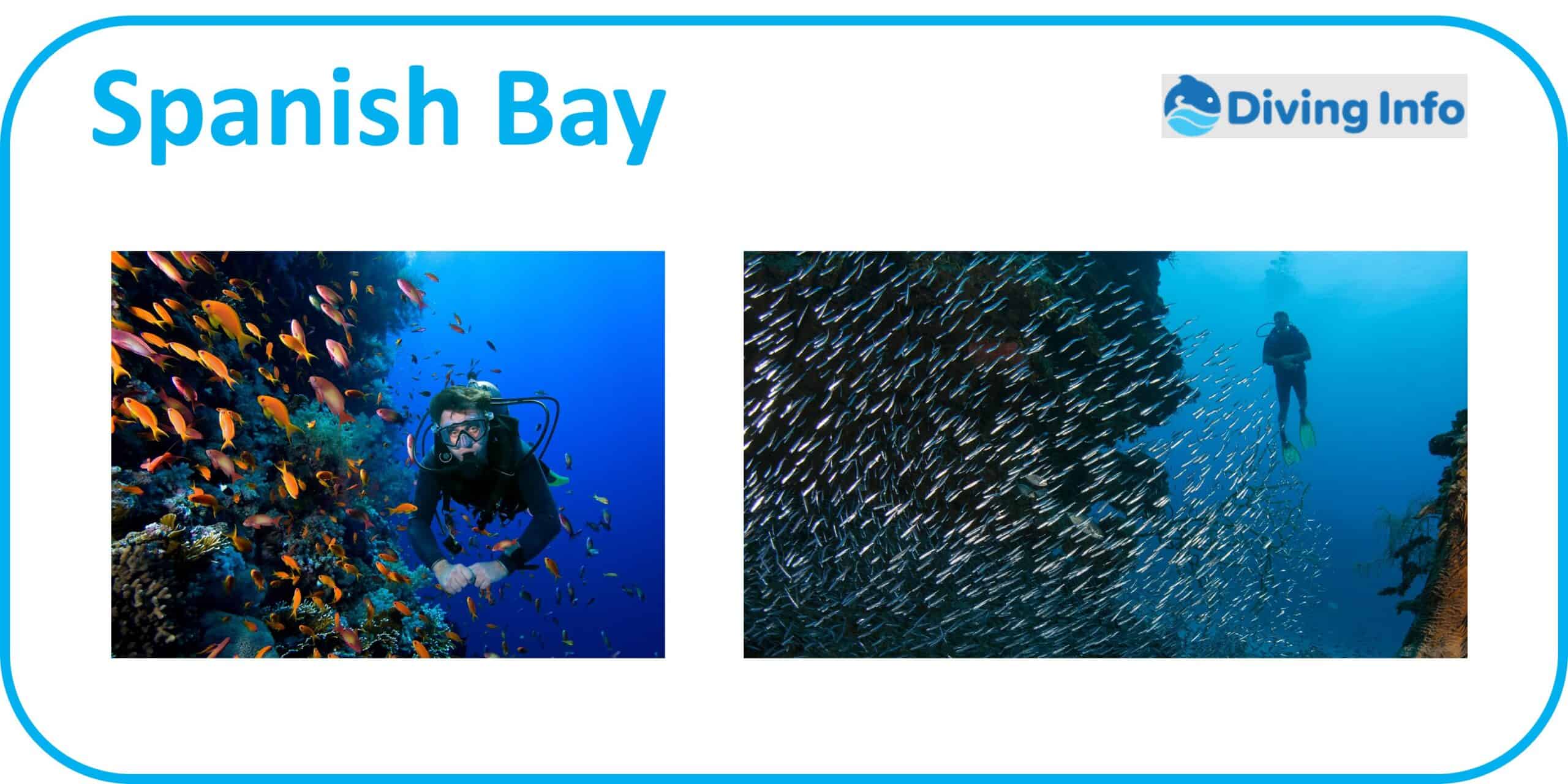
Spanish Bay is a beautiful and unique diving spot located in the southern region of Belize. It is a great location if you want to experience something different from the typical reef diving, as it has its own distinct features that make it stand out.
One of these features is the stunning seagrass meadow that covers the ocean floor. This ecosystem is home to many different species, including manatees, rays, and turtles.
Divers can easily spot these animals while scuba diving in Belize waters at Spanish Bay. The seagrass also serves as a nursery for fish species such as barracuda, snapper, and grouper.
| Description | A beautiful and unique diving spot located in the southern region of Belize with distinct features that make it stand out. |
| Unique Features | Stunning seagrass meadow that covers the ocean floor, underwater cave systems, and swim-throughs. |
| Best Time to Visit | Peak scuba diving season (April-May) |
| Dive Depth | Up to nearly 100ft/ 30 meters deep. |
| Experience Level Required | More advanced levels will be able to explore parts of the caves systems and visit deep ledges. |
So not only is it great for marine life sightings but it’s also great for underwater photography. Another feature of Spanish bay that makes it stand out from other dive sites in Belize is its underwater cave systems or swim-throughs which offer a unique perspective on marine life along with interesting photo opportunities.
Diving through the cave-like formations you’ll see colorful sponges and soft corals growing along the walls and ceilings, with schools of fish swimming above you illuminated by natural light coming through narrow openings above. This dive site also offers an opportunity to experience some deeper dives up to nearly 100ft/ 30meters deep where more advanced levels will be able to explore parts of the caves systems and visit deep ledges where giant gorgonians sway in currents providing refuge for small critters like Pygmy Seahorses and rare nudibranchs.
The visibility at Spanish Bay can vary but generally ranges between 50-70 feet (15-21 meters). During peak scuba diving season (April-May) visibility may be reduced due to plankton blooms but this can attract whale sharks further offshore making it worth checking out.
Overall, Spanish Bay should definitely be included on your itinerary when planning your next trip scuba diving in Belize. It offers a unique experience with diverse marine life, underwater caves, swim-throughs and stunning seagrass ecosystems that are not only great for divers but also snorkelers.
8. The Silk Cayes Wall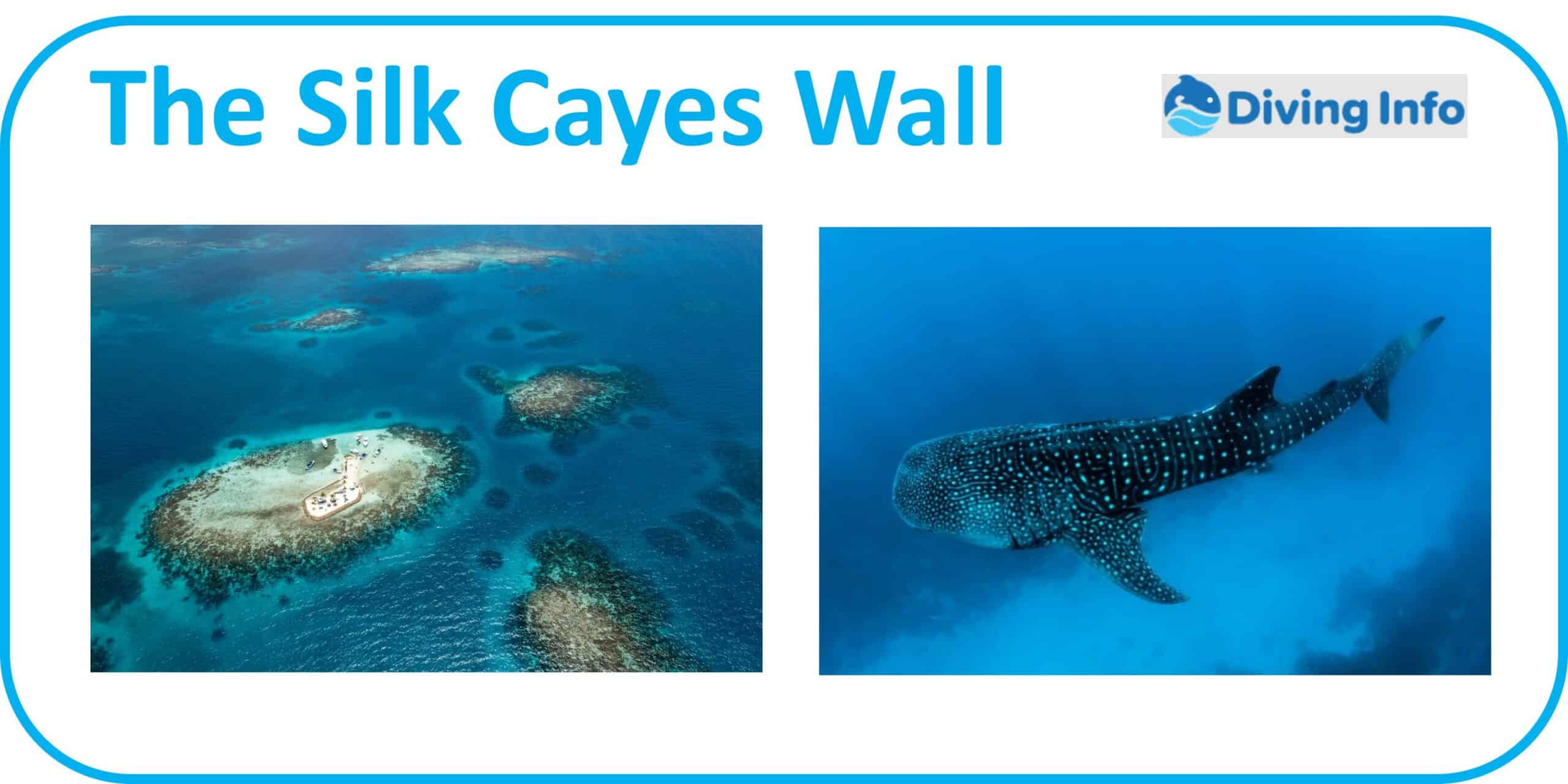
The Silk Cayes Wall is a must-dive site for anyone who wants to experience the best of Belize diving. The underwater scenery is breathtaking, and the marine life is abundant.
This dive site is located within the stunning Silk Cayes Marine Reserve which is a protected area making it home to some of the most vibrant and diverse reef systems in Belize. Divers can expect to see a variety of fascinating marine species such as tropical fish, octopus, moray eels and lobsters while scuba diving in Belize at The Silk Cayes Wall.
It’s also an ideal spot for observing sea turtles in their natural habitat. The wall itself offers a fantastic opportunity to explore overhangs, crevices, and nooks where you can find various species hidden away.
| Description | A must-dive site located within the stunning Silk Cayes Marine Reserve which is a protected area making it home to some of the most vibrant and diverse reef systems in Belize. |
| Unique Features | The wall that drops down from 20 feet (6 meters) until it reaches 100 feet (30 meters), huge and impressive sponges covering the wall. |
| Best Time to Visit | Not specified. |
| Dive Depth | From 20 feet (6 meters) to 100 feet (30 meters). |
| Experience Level Required | Suitable for divers of all skill levels. |
The dive follows the wall that drops down from 20 feet (6 meters) until it reaches 100 feet (30 meters), offering a perfect view of an array of small creatures living here.The sponges covering the wall are huge and impressive with colors ranging from bright oranges and yellows to deep purples, reds, and greens. Following the dive guide will lead you through canyons carved out by water movements over time.
Currents can be mild or strong depending on tides but since this is not an advanced level dive spot divers of all skill levels can enjoy exploring this underwater paradise during their scuba diving in Belize experience. There are also mild currents that bring nutrients that attract pelagic fish like tuna or barracudas which makes for great opportunities for photographers.
Scuba diving at The Silk Cayes Wall promises an unforgettable adventure for divers who want to see some spectacular marine life up close while enjoying a beautiful underwater landscape. Definitely add this destination on your list when planning your next trip for scuba diving in Belize!
9. The Long Caye Aquarium
The Long Caye Aquarium is a must-visit site if you’re scuba diving in Belize. This dive spot is located within the Lighthouse Reef Atoll, and it’s the perfect place to explore some of Belize’s most impressive coral formations. The Long Caye Aquarium has plenty of hard and soft corals that are home to an array of marine life.
As you descend into the water at the Long Caye Aquarium, be prepared to be amazed by the vibrant colors of the corals and fish that surround you. You’ll likely see schools of colorful fish swimming by, as well as lobsters, eels, octopuses, and plenty of other critters.
| Description | A must-visit site if you’re scuba diving in Belize. This dive spot is located within the Lighthouse Reef Atoll. |
| Unique Features | The dive spot consists of a series of sheer walls that drop down into deeper waters. |
| Best Time to Visit | During off-peak times to avoid crowds. |
| Dive Depth | Varies. |
| Experience Level Required | All levels. |
One thing that makes the Long Caye Aquarium so special is its unique topography. This dive spot consists of a series of sheer walls that drop down into deeper waters.
As you make your way along these walls, keep an eye out for caves and crevices where marine life likes to hide. One highlight of diving at the Long Caye Aquarium is spotting nurse sharks.
These docile creatures like to rest in shallow waters during daylight hours, so keep an eye on sandy patches between coral heads where they might be hiding. Another thing to note about diving at the Long Caye Aquarium is that it can get quite busy with other divers and snorkelers.
However, don’t let this deter you from experiencing this incredible dive site for yourself – just try to visit during off-peak times if possible. Overall, diving at the Long Caye Aquarium offers a unique opportunity to explore some stunning underwater scenery in Belize’s beautiful Lighthouse Reef Atoll.
10. Half Moon Caye Wall
Half Moon Caye Wall is a must-visit dive site for those who want to experience the best of scuba diving in Belize. Located on the east side of Half Moon Caye, this site features a wall that drops from 25 feet to over 100 feet deep.
The wall is covered with beautiful coral formations, and there are plenty of opportunities to see marine life up close. One of the highlights of diving at Half Moon Caye Wall is the chance to see large schools of fish swimming along the wall.
| Description | A must-visit dive site located on the east side of Half Moon Caye. |
| Unique Features | Features a wall that drops from 25 feet to over 100 feet deep and covered with beautiful coral formations. |
| Best Time to Visit | Not specified. |
| Dive Depth | From 25 feet to over 100 feet deep. |
| Experience Level Required | Not specified. |
You may see blue tangs, sergeant majors, and grunts, among others. Barracudas are also common here, and they often swim close to divers without showing any fear.
Another attraction at Half Moon Caye Wall is the chance to see eagle rays gliding through the water. These graceful creatures are often spotted in this area, and they may swim right up to you if you’re lucky.
Divers who explore Half Moon Caye Wall will also have a chance to see some larger creatures like reef sharks and nurse sharks. These animals are generally not aggressive towards humans, but it’s still important to keep a respectful distance from them.
If you’re interested in underwater photography, then Half Moon Caye Wall is definitely worth a visit. The clear water and abundant marine life make for some stunning shots that you’ll be proud to show off back home.
Overall, Half Moon Caye Wall is an excellent dive site that showcases why Belize is such a popular destination for scuba divers around the world. With its stunning coral formations and diverse marine life, this site provides an unforgettable experience that will leave you with memories for years to come.
11. Glover’s Atoll
Glover’s Atoll is one of the most remote and least visited atolls in Belize, but it is an ideal location for scuba diving enthusiasts looking for a unique dive experience. The atoll is located 45 miles from the Belize mainland and can only be accessed by boat or liveaboard. The diving experience in Glover’s Atoll is nothing short of amazing.
The water is crystal clear with visibility up to 60 feet below the surface, making it perfect for scuba diving. There are over 700 patch reefs within the atoll itself, which provide an incredible opportunity to see diverse marine life and beautiful coral formations.
| Description | One of the most remote and least visited atolls in Belize, located 45 miles from the Belize mainland. Can only be accessed by boat or liveaboard. |
| Unique Features | Over 700 patch reefs within the atoll itself, a dive site called “The Wall” with a dramatic drop-off, and “Octopus Alley” known for its excellent visibility and a large number of octopuses. |
| Best Time to Visit | Not specified. |
| Dive Depth | Visibility up to 60 feet below the surface. |
| Experience Level Required | More suitable for experienced divers due to its remote location and lack of tourist infrastructure on land. |
Diving in Glover’s Atoll offers a chance to see some of the rarest marine species that are not found anywhere else in Belize. At this dive spot, you can find massive schools of jacks, groupers, barracudas and snappers.
The most sought-after species here are hammerhead sharks, which you’ll rarely find in other places while scuba diving in Belize. One of the highlights of Glover’s Atoll is a dive site called “The Wall”, which has a dramatic drop-off that plunges into deep blue abyssal water.
Divers will find themselves surrounded by colorful sponges, sea fans, soft corals and gorgonians clinging to the steep walls. Another must-visit site here while scuba diving in Belize is called “Octopus Alley”.
It is known for its excellent visibility and a large number of octopuses that inhabit the area. Divers will also encounter eagle rays gliding past them while admiring beautiful coral formations.
Overall, Glover’s Atoll guarantees an unforgettable underwater experience with its rare species of fish, stunning coral walls and clear waters when scuba diving in Belize. However, due to its remote location and lack of tourist infrastructure on land makes it more suitable for experienced divers who don’t mind going off the beaten track.
12. Ambergris Caye
Ambergris Caye in Belize is an unparalleled diving destination renowned for its breathtaking dive sites and rich marine life. Situated in an incredibly diverse aquatic ecosystem, Ambergris Caye provides both novice and experienced divers with a unique and unforgettable underwater adventure. Guided diving and snorkeling tours are offered to facilitate the exploration of this underwater paradise.
The Ambergris Caye dive sites, such as Robles Point with its distinctive canyon formations, and Punta Arena Caverns, renowned for its deep canyons and tunnels, serve as gateways to a world teeming with marine life. From spotted eagle rays and nurse sharks to sea turtles, the dive sites offer once-in-a-lifetime encounters with some of the most fascinating aquatic species.
| Description | Ambergris Caye is a pristine diving destination located in Belize, known for its spectacular dive sites and diverse range of marine life. |
| Unique Features | Ambergris Caye hosts various unique dive sites, including the canyon formations of Robles Point and the deep canyons and tunnels of Punta Arena Caverns. The island also offers guided diving tours. |
| Best Time to Visit | The best time to visit Ambergris Caye for diving is from November to May, during which the weather is dry and visibility is at its best. However, diving is possible year-round. |
| Dive Depth | The dive depth varies depending on the site, but the visibility is generally excellent. |
| Experience Level Required | Diving in Ambergris Caye is suitable for all levels of divers. Beginners can enjoy the Punta Azul Canyons with its canyon arches, while Rocky Point Canyons offers a more challenging dive for experienced divers. |
Diving in Ambergris Caye offers awe-inspiring experiences irrespective of one’s skill level, making it a compelling destination for divers aiming to hone their skills. Dive sites like Rocky Point Canyons, notable for its vibrant coral and tarpon hole, cater to advanced divers seeking a challenge. In contrast, Punta Azul Canyons, with its arches crafted by gentle currents, is suited for divers of all experience levels.
Diving is optimal from November to May when the weather is dry, and visibility is excellent. However, Ambergris Caye welcomes divers year-round, with each season offering unique experiences. Divers can explore diverse sites, from the densely populated Basil Jones Canyons to Cypress Canyons, famous for its concentration of elkhorn coral.
In conclusion, Ambergris Caye in Belize is a diving haven boasting an assortment of stunning dive sites and marine life. Its unique diving experiences and incredible biodiversity make it a must-visit destination for diving enthusiasts.
Belize Diving Conditions
Before planning a scuba diving trip to Belize, it’s essential to know what kind of diving conditions you can expect. Belize is home to some of the best dive sites in the world, but the diving conditions can vary depending on the location and time of year. Here are some things you should know about the diving conditions in Belize.
Visibility
Belize is renowned for its crystal-clear waters and excellent visibility, making it a dream destination for scuba divers.
The water clarity is often better than 100 feet or more, which makes it easier to spot marine life and take underwater photographs. In some areas like Hol Chan Marine Reserve, the visibility can sometimes drop slightly due to plankton blooms during certain times of year.
Water temperature
The water temperature in Belize ranges from 79°F (26°C) – 83°F (28°C) year-round, making it ideal for scuba diving.
You’ll be comfortable whether you’re wearing only a shorty wetsuit or a full 3mm wetsuit. Currents:
Most dive sites in Belize have mild currents that are easy to navigate even for less experienced divers. However, there are a few exceptions where strong currents can be found.
For example, at Gladden Spit during full moons between March and June every year when whale sharks gather to feed. Depth:
Belize offers diverse diving opportunities with depths ranging from shallow coral gardens and patch reefs to steep walls that drop hundreds of feet into the abyss. Most dive sites range between 30-80ft deep but there are also deeper sites available such as The Blue Hole that reaches up to 130ft deep.
Weather
The weather in Belize is tropical with two distinct seasons: dry season (December – May) and wet season (June – November).
During dry season weather patterns are calm with light winds most days providing excellent boating conditions for scuba diving trips while wet season brings rain showers along with a few thunderstorms. However, even during the wet season, it’s rare for storms to last all day, and most days are still suitable for scuba diving in Belize.
Belive Diving Information
Belize is a world-class scuba diving destination. The country’s clear, warm waters are home to a diverse range of marine life, and its numerous dive sites offer something for every level of diver. In this section, we’ll explore some of the key information you need to know before scuba diving in Belize.
Firstly, let’s discuss how to dive Belize. There are plenty of dive operators throughout the country offering guided dives suitable for all levels of experience.
Whether you’re a beginner or an experienced diver, there will be something to suit your needs. Some operators even offer tailored packages that include accommodation and transfers.
When planning your trip to Belize, it’s important to consider the best time to dive. Generally speaking, the dry season from November until May offers the best conditions for diving in Belize.
During this time you can expect clear skies and calm seas with water temperatures hovering around 80°F (27°C). The rainy season from June through October can bring stormy weather and rough seas.
If you’re new to scuba diving or haven’t dived for some time, it’s important to get properly certified before jumping into the water. There are plenty of accredited PADI dive centers throughout Belize that offer courses at all levels from beginner through advanced open water.
When scuba diving in Belize, it’s important to be aware of any potential hazards such as strong currents or deep drop-offs. Always listen carefully to your guide or instructor when they brief you on the dive site and follow their instructions closely.
Before you go scuba diving in Belize it’s worth familiarizing yourself with some local customs and laws related to marine conservation. Protecting delicate ecosystems like those found in Belize is crucial for preserving our oceans for future generations – so make sure you do your part by following responsible diving practices!
How to Dive Belize
Ready to dive into the underwater world of Belize? Before you jump in, you’ll need to know how to dive in Belize. Here’s what you need to know:
First things first, you’ll want to make sure that you’re certified for scuba diving in Belize. Most dive operators require an Open Water certification from a recognized agency such as PADI or NAUI.
Don’t worry if you’re not yet certified, there are plenty of dive schools around the country where you can get your certification and start exploring the beautiful waters of Belize. When choosing your dive operator, make sure that they have professional and experienced instructors who will give you a thorough briefing on the local conditions before each dive.
This includes information on currents, tides and any potential hazards in the area. They should also be able to provide all necessary equipment, including tanks and weights.
In general, diving in Belize is easy and suitable for all levels of divers. The water is usually warm (around 80°F) and visibility is great – up to 100 feet on a good day!
Currents are generally mild but can be stronger at specific sites like Blue Hole or Half Moon Caye Wall. It’s important to remember that marine life in Belize is protected by law, so it’s vital that divers follow responsible diving practices such as maintaining proper buoyancy control and avoiding touching or harassing wildlife.
To help protect these precious ecosystems, many operators offer environmentally-friendly dives where divers can learn about coral restoration projects or participate in lionfish culling activities. Don’t forget that scuba diving isn’t just about what’s underwater – it’s also about enjoying the topside culture!
Many operators offer trips to local villages where you can experience traditional Garifuna music and dance performances or sample delicious local cuisine like conch fritters or fry jacks. Now that you know how to scuba dive in Belize like a pro, it’s time to jump in and start exploring the beautiful underwater world of this amazing country!
Best Time to Dive Belize
When it comes to scuba diving in Belize, the timing of your visit is crucial. The best time to dive depends on a couple of factors, including weather and water conditions, visibility, marine life sightings, and crowds.
The country has two distinct weather seasons: the dry season and the wet season. The dry season runs from November to April and is considered the best time to go diving in Belize.
During this period, you can expect sunny days with minimal rain showers and calm sea conditions. Visibility is at its peak, ranging from 30-40 meters (100-130 feet) or more, making it ideal for underwater photography enthusiasts.
On the other hand, the wet season in Belize lasts from May to October. Although it’s technically hurricane season during this time of year, tropical storms are not that common in Belize due to its location outside of the hurricane belt.
However, rains are frequent during this period that can affect water visibility levels and make some dive sites inaccessible. One factor that makes scuba diving in Belize exceptional is that many marine species have specific breeding patterns throughout different periods of the year.
For example, whale sharks migrate through Belizean waters between March and June each year – an event you wouldn’t want to miss if possible! Additionally, humpback whales visit between December through April; while manatees tend to be most active between June through September.
Another consideration you need to keep in mind when planning your trip for scuba diving in Belize is how busy dive sites become throughout the year. Generally speaking: High tourist traffic times are around Christmas/New Years’, Easter holidays (March – April), July/August months – so if you want fewer crowds at popular dive spots like Hol Chan or Turneffe Atoll Reserve – plan your trip accordingly!
: The best time for scuba diving in Belize is during the dry season (November-April). However, if you’re looking to spot specific marine species, you may need to plan your trip accordingly.
If you’re not a fan of crowds, avoid visiting during high tourist seasons like Easter or Christmas/New Year’s. Keep in mind the weather and water conditions can vary from year to year so it’s always a good idea to plan ahead and talk with local dive operators for their insight and advice!
Things to Do in Belize
Belize is a unique destination that has plenty of activities for visitors aside from scuba diving. The country is known for its lush tropical jungles, ancient Mayan ruins, and barrier reef.
Visitors can explore the culture, cuisine, and natural beauty of the country when they are not underwater. One of the top things to do in Belize is to visit the ancient Mayan ruins.
There are several sites located throughout the country that offer visitors an opportunity to learn about Maya civilization. Some of the most popular sites include Xunantunich, Altun Ha and Lamanai.
Visitors can also take part in a jungle tour where they get to see exotic animals such as howler monkeys, jaguars and tapirs. Belize has over 200 islands so it’s no surprise that beach lovers will find plenty of places to relax while on vacation.
Placencia Peninsula is home to some incredible white sand beaches that you won’t want to miss. Hopkins Village also has some beautiful stretches of sand that are perfect for swimming or sunbathing.
The Belize Zoo is another popular attraction for those visiting the country. What makes this zoo unique is that it only houses animals native to Belize’s forests and jungles.
Visitors can expect to see jaguars, tapirs, snakes, crocodiles and much more. Visitors who want a thrill should consider going cave tubing in Belize’s crystal clear watersheds which offers an exhilarating adventure through underground rivers systems with stunning rock formations.
Belize has a rich cultural heritage with influences from Africa, Europe and Central America which has resulted in a unique blend of music styles including brukdown , punta rock , soca , reggae , calypso among others . It’s easy for visitors to immerse themselves in this vibrant music by attending local festivals or visiting nightclubs where live performances by local artists are held regularly.
When traveling abroad it’s always great when there are things to do outside of your main activity. Belize is a destination that has plenty of activities that mix well with scuba diving, so visitors will never run out of things to do while on vacation.
How to Get to Belize
When it comes to getting to Belize, you have a few options. One popular choice is flying. Philip S.W. Goldson International Airport in Belize City is the main entry point for most travelers.
There are direct flights from major cities such as Miami, Houston, and Atlanta, and connecting flights from other destinations. Once you arrive at the airport, you can take a taxi or shuttle to your final destination.
Another option is taking a bus or driving if you’re coming from Mexico or Guatemala. There are several border crossings that allow for land travel into Belize.
If you’re interested in scuba diving in Belize’s coastal waters, another option is arriving via boat. Many liveaboard dive boats depart from ports in nearby countries like Mexico and Honduras and make their way to various dive sites throughout Belize.
No matter how you get there, make sure to have all of your necessary travel documents in order before arrival. This includes a passport that will be valid for at least six months after your planned departure date and any required visas or permits.
If you’re planning on bringing your own scuba gear, check with your airline beforehand about any restrictions on baggage size or weight limits. Some airlines may charge extra fees for oversized or overweight bags.
Overall, getting to Belize is relatively easy and straightforward no matter which mode of transportation you choose. Once there, it’s time to start exploring the beautiful underwater world that makes this country such a popular destination for scuba divers!
Belize Liveaboards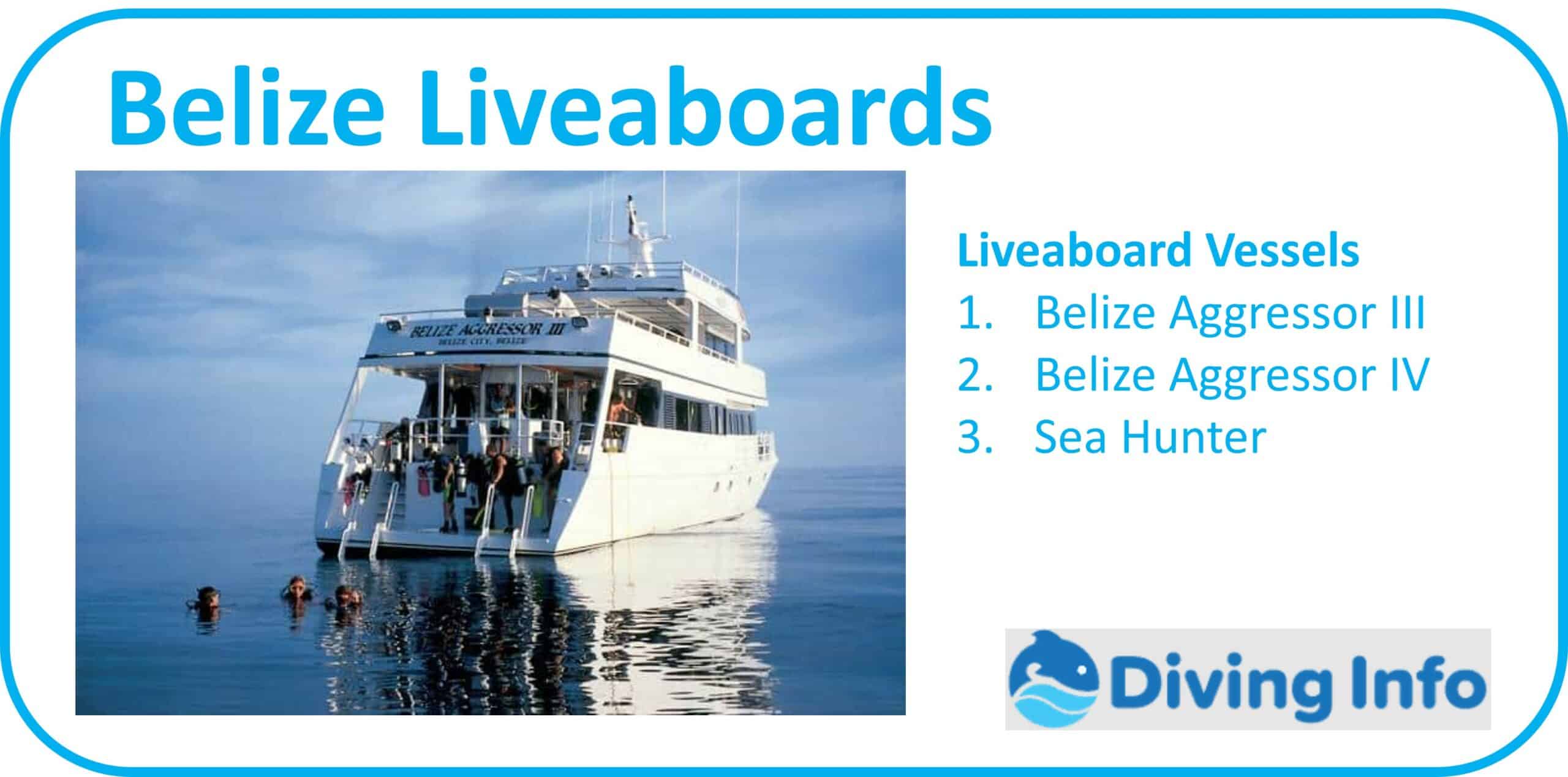
Belize liveaboards are a great way to experience the best scuba diving in Belize. Many liveaboards in Belize offer 7 to 10-night dive expeditions, allowing divers to visit far-off dive sites that cannot be accessed by day boats.
Liveaboard trips can take you to some of the most remote dive sites where schools of hammerheads and whale sharks can be found. Many liveaboards in Belize offer air-conditioned cabins with en-suite bathrooms and comfortable shared spaces for relaxation between dives.
Divers can also enjoy delicious meals prepared by professional chefs and snacks throughout the day. Most liveaboards have a spacious dive deck with plenty of storage for scuba gear and easy access to the water.
One of the most popular areas for liveaboard diving in Belize is Glover’s Atoll, which is located 50 miles offshore from mainland Belize. Glover’s Atoll boasts an incredible diversity of marine life, including over 700 species of fish, sharks, rays, turtles and dolphins.
The atoll has several pristine coral reefs that are home to vibrant schools of fish, colorful sponges and sea fans. Another popular destination for liveaboard diving in Belize is Lighthouse Reef Atoll, located about 50 miles east of mainland Belize City.
Lighthouse Reef Atoll is home to one of the most iconic dive sites in the world – the Great Blue Hole. This underwater sinkhole is over 300 meters wide and almost 125 meters deep and is surrounded by beautiful coral formations.
Liveaboards also frequently visit Turneffe Atoll which has been described as one giant aquarium because you’re constantly surrounded by marine life during your dives here! You’ll see schools of colorful fish such as blue tangs or grunts swimming around massive coral heads or beneath overhangs along with healthy populations of reef sharks patrolling their territories.
Overall if you’re looking for an immersive experience while scuba diving in Belize, a liveaboard is definitely the way to go. You’ll get the chance to visit remote and pristine dive sites with rich marine life while also enjoying comfortable accommodations and delicious meals during your trip.
Dive Operators in Belize
If you’re planning a scuba diving trip to Belize, you’ll almost certainly need a reliable dive operator. While many of the best dive sites in Belize are reachable by shore, others are only accessible via boat. Even if you’re an experienced diver, it’s always better to dive with someone who knows the area and can ensure your safety.
Here are just a few of the many dive operators in Belize.
Amigos del Mar
One of the most well-known dive operators in Belize is Amigos del Mar. This company has been operating since 1987 and is based on Ambergris Caye, one of the most popular destinations for scuba diving in Belize. Amigos del Mar offers trips to some of the best sites on the Belize Barrier Reef, including Hol Chan Marine Reserve and Shark Ray Alley.
They also offer certification courses for beginners and advanced divers.
Island Divers Belize
Another great option for divers is Island Divers Belize, which operates out of Caye Caulker, another popular destination for scuba diving in Belize. This company offers daily trips to some of the best sites around Caye Caulker and Ambergris Caye, as well as longer trips to more remote locations like Lighthouse Reef and Glover’s Atoll.
Splash Dive Center
If you’re interested in combining scuba diving with other activities like snorkeling or kayaking, then Splash Dive Center might be a good choice for you.
This company has been operating since 2000 and offers a wide range of adventure tours that include visits to some of the best dive sites around Ambergris Caye.
Barefoot Watersports
For those looking to explore more off-the-beaten-path dive spots in Belize, Barefoot Watersports might be worth considering. This small company operates out of Placencia on the southern coast of Belize and offers trips to less-visited locations like Gladden Spit and Silk Cayes Wall.
Belize Dive Haven
If you’re looking for a more luxury-oriented experience while scuba diving in Belize, you might want to check out Belize Dive Haven. This dive resort is located on Turneffe Atoll and offers all-inclusive packages that include meals, accommodations, and scuba diving trips. They also have their own fleet of boats and a staff of experienced dive instructors.
Dive Resorts
Dive Resorts: Belize is a popular scuba diving destination, and there are a variety of dive resorts to choose from.
These resorts cater to divers of all experience levels and offer a range of amenities to make your dive trip as comfortable and enjoyable as possible.
Turneffe Island Resort
One popular dive resort in Belize is the Turneffe Island Resort. This all-inclusive resort is located on its own private island, which means that diving opportunities are right at your doorstep. The resort has its own on-site dive center, which offers daily dives and certification courses.
The rooms at the Turneffe Island Resort are comfortable and spacious, with large windows that provide stunning views of the Caribbean Sea.
Ramon’s Village Resort
Another top-rated dive resort in Belize is the Ramon’s Village Resort in San Pedro. This resort is located on Ambergris Caye, which is known for its beautiful coral reefs and diverse marine life.
Ramon’s Village Resort has its own on-site dive shop, which offers everything from beginner courses to advanced technical diving trips. The accommodations at Ramon’s Village Resort are cozy and charming, with thatched-roof cabanas nestled among lush tropical gardens.
Victoria House Resort & Spa
For those looking for a more luxurious scuba diving experience in Belize, the Victoria House Resort & Spa might be just what you’re looking for.
This elegant resort is located on Ambergris Caye and has a private marina where you can set out on your dives. The Victoria House Resort & Spa also offers spa services to help you relax after a day of exploring Belize’s beautiful underwater world.
Thatch Caye Eco-Resort
If you’re interested in eco-friendly scuba diving options in Belize, check out Thatch Caye Eco-Resort. This off-grid retreat focuses on sustainability and conservation while still providing guests with top-notch diving experiences.
Thatch Caye Eco-Resort has its own on-site PADI-certified dive center, where guests can take courses or go on guided dives around the surrounding reefs.
Belizean Dreams Resort
For those looking for a more budget-friendly option, there’s the Belizean Dreams Resort. This resort is located in Hopkins Village and offers a range of affordable dive packages.
The Belizean Dreams Resort has its own on-site dive center, which offers trips to nearby dive sites like Gladden Spit and Silk Cayes Wall. The resort’s accommodations are comfortable and come with all the necessary amenities to make your stay enjoyable.
No matter what type of scuba diving experience you’re looking for in Belize, there’s a dive resort that will fit your needs. From luxurious private islands to eco-friendly retreats, these resorts offer everything from beginner courses to advanced technical diving opportunities.
Conclusion
Belize is an exceptional destination for diving enthusiasts. With its crystal clear waters and abundant marine life, it offers a unique experience that cannot be found anywhere else in the world.
The country’s commitment to conservation and sustainability has helped preserve its underwater treasures, making it a must-visit destination for any scuba diver. Whether you are a novice or an experienced diver, Belize has something to offer everyone.
From exploring the breathtaking Great Blue Hole to swimming with nurse sharks at Shark Ray Alley, there is no shortage of incredible dive sites in this beautiful country. The diverse marine life includes colorful corals, schools of tropical fish, rays, turtles, eels and even whale sharks if you time your trip right.
Aside from diving itself, Belize also offers plenty of other activities to enjoy during your trip. You can explore ancient Mayan ruins like Lamanai or Altun Ha on land tours; relax on pristine beaches; go kayaking in mangrove forests; or experience cultural immersion visiting local villages and meeting the friendly people who call Belize home.
When planning your trip to scuba dive in Belize, it’s important to choose the right dive operator or resort that suits your needs. There are many options available depending on your budget and preferences – from liveaboards for more remote diving adventures to all-inclusive resorts where everything is taken care of for you.
Overall, if you’re looking for an unforgettable scuba diving experience that combines adventure with relaxation and culture – look no further than Belize. With its stunning natural beauty both above and below the water line plus warm weather year-round- it truly is a one-of-a-kind destination that will leave you with memories that last a lifetime!

